It’s early summer in Moldova, and the cherries are already ripe. Fellow journalist Marian Männi and I pick and pop them into our mouths as we follow our chosen tour guide up a hill. We are exploring Old Orhei, a famous Moldovan landmark and archaeological site. It consists of three villages: Trebujeni to the north, Butuceni to the west and Morovaia to the east. The area is built on a green field, and the Răut River runs through it.
Following the guide’s lead, we climb a hill to find one of many cave monasteries. This one is rather hidden, so most tourists miss it entirely.
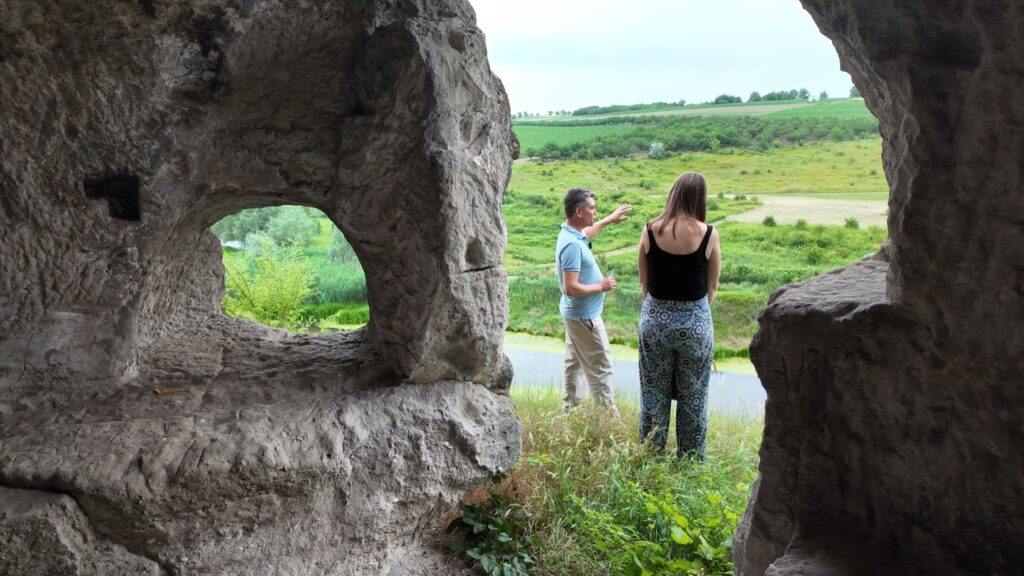
My guide showcases a cave monastery above the Răut River, where tourists rarely find their way. Author’s photo.
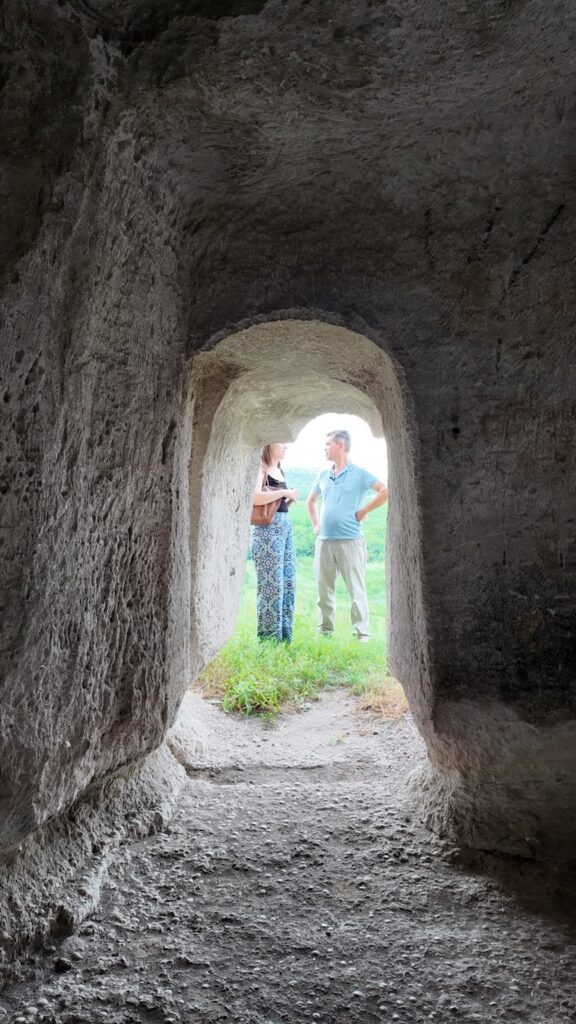
A picture from the inside of the cave looking out. Author’s photo.
The surrounding area is an unusual sight. The sloping bank of the Răut River emerges from a perfectly flat field, looking almost man-made. However, it is a natural reminder of how landscapes evolve. You can find perfect seashells on the limestone bank in a country with no coastline, much like on a sandy beach. Millions of years ago, the Răut River was part of the ancient Sarmatian Sea, just like the lands of today’s Moldova.


Scenic views of Old Orhei. One can barely see the river under the hill. Author’s photo.
My guide, Professor Sergiu Musteață, knows this site incredibly well. He is a renowned historian from Moldova and a professor at the Faculty of Philology and History at “Ion Creangă” State Pedagogical University. He has worked to educate locals about the history of Old Orhei and how to develop tourism businesses. He has also guided them in creating guesthouses and writing proposals for funding to build flushing toilets in their homes.
Old Orhei has been one of the main subjects of his research since 1996. “I know everyone in Orheiul Vechi [the Romanian version of the name]!” he laughs. He also knows all of the approximately 300 caves in the area and has personally researched many of them.

Professor Sergiu Musteață says that people working in Moldovan tourism need to understand that the basis of it is history and heritage. Author’s photo.
A scenic journey through unknown sites
Musteață leads us along a hidden path lined with cherry trees from an old student’s base. Researchers have been excavating this area for decades, as the unique landscape reveals layers of settlements dating back to prehistoric times.
“When we come here with students, we usually clean the neighborhood and cut the grass first,” Musteață says, pushing branches away from the path. If only tourists knew about this shortcut hidden in nature.

Professor Musteață peers through a rustic gate. Author’s photo.
“We have organized 20 years of summer camps for the locals during the excavations, including summer schools for local kids. Lots of students, both locals and internationals, participated!” he states emphatically.
Despite many efforts, only a few locals have made a name for themselves in the tourism sector. “I don’t know why. There is not so much interest. It should be the most prominent place among tourists,” Musteață comments.
Unlike other visitors, we walk past the Peștera cave monastery, the main tourist attraction of Old Orhei. The current underground tunnels date back to 1820. However, the caves in these limestone hills have existed since the 14th century. Orthodox monks found solitude and a place for spiritual retreat in this isolation.
“There is another cave monastery here. Locals know about it, but only a few tourists will visit it,” says Musteață. This is where we are heading.
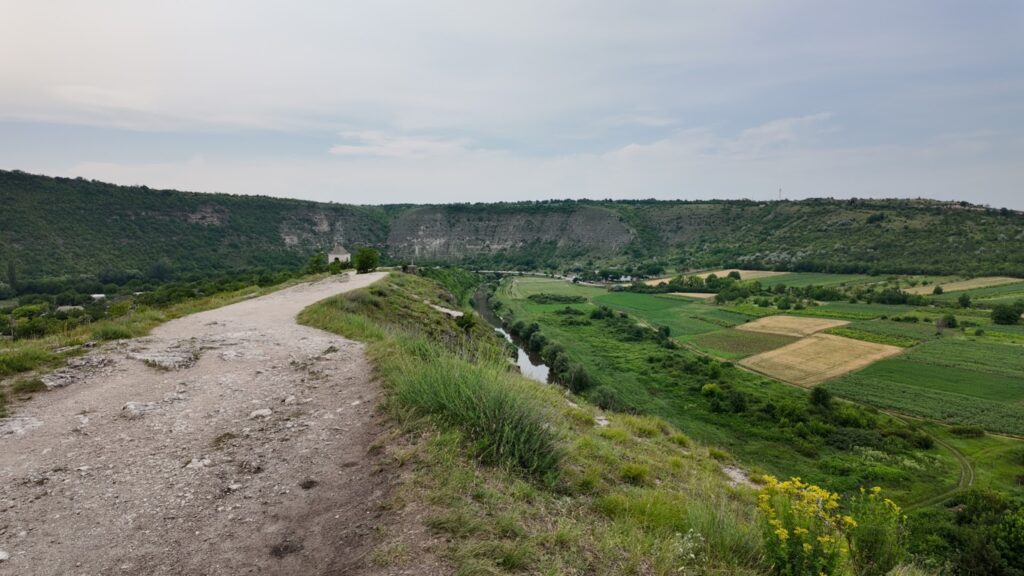
We walk past the Peștera cave monastery and head off-road to find another lesser-known monastery. Author’s photo.
We walk on the bank, passing through the Church of Ascension of St. Mary. The view of the valley and fields is breathtaking. Turning left, the professor leads us onto an almost unrecognizable road downhill from the bank. Our slippers aren’t ideal footwear for this leg of the journey, but nevertheless, we climb down the limestone bank to a land of grazing cows.
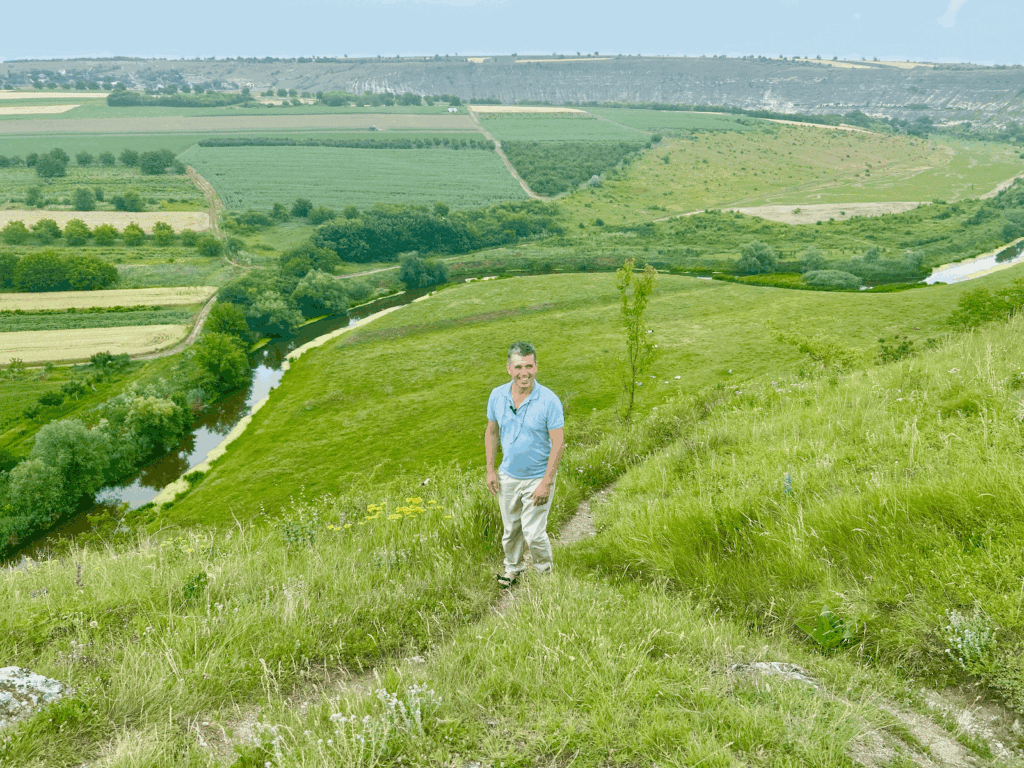
Musteață guides us onto a new path, leading down the limestone bank. Author’s photo.
After walking, we climb again to another obscure cave monastery of Old Orhei, built above the Răut’s waters. There isn’t a single soul up here now, but historically, monks isolated themselves in this cave. As a result, the monastery is covered in signs of human habitation.
The church’s facade is engraved with Slavonian writing: “This church was built by the slave of Bosie, pircalab (Chief Magistrate) of Orhei, together with his wife and his children, to cherish God, to forgive his sins.”
The professor shows us around. We see where the monks would sleep and where they built their fireplace. All the caves are in remarkably good shape, with few signs of dripping rocks.

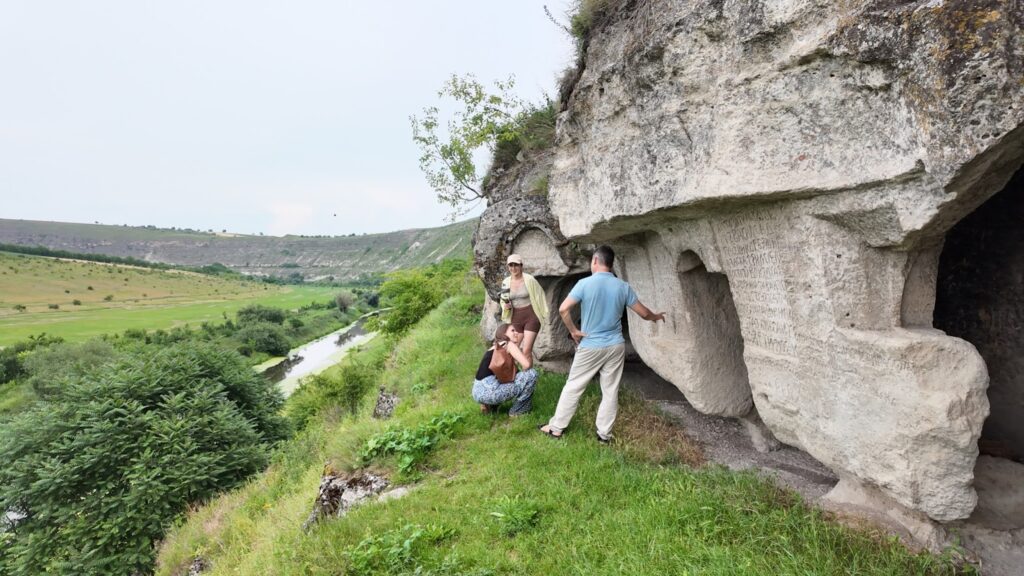
We view the monastery’s exterior, which has endured for centuries. Author’s photo.
This structure often goes unexplored by tourists. “It’s a bit too far and difficult to access. That’s why people don’t know much about it and wouldn’t end up here,” Musteață explains.

Musteață teaches us about the monastery. Author’s photo.
On the whole, Old Orhei is a fascinating, history site. And its antiquity is richer than one might expect.
Mankind has loved this region since ancient times
The surroundings have been populated since the Paleolithic era due to good location — the river protects Old Orhei from three sides. The land is suitable for agriculture and flowing water is nearby.
Archaeological findings suggest that the Getians built some fortresses and settlements in this region during the 4th to 3rd centuries BCE, taking advantage of the natural fortifications provided by the rocky outcroppings and riverbanks.
In the 14th century CE, Old Orhei became part of the medieval state of Moldova (Țara Moldovei) after the collapse of the Golden Horde, a Mongol-Tatar state that controlled this territory as well.
After the Tatar period in the 12th to 14th centuries, an Orthodox Christian community developed during medieval times. Political stability and the protective embrace of nature made Old Orhei an important center. Moldovan hero and ruler Stephen the Great, whose rule lasted from 1457 to 1504, appointed his uncle, Peter III Aaron, to rule there. The area was fortified with strong defensive walls and towers.
Life in Old Orhei slowly faded in the 17th century. The administration moved to neighboring New Orhei, and gradually, the monastic community began to disappear. The last monks are believed to have left Old Orhei at the beginning of the 19th century. By this time, many monastic communities in the region faced significant challenges due to political changes, invasions and pressures from the expanding Ottoman Empire. The decline in monastic life at Old Orhei was part of a broader trend affecting many religious sites in the region.
At the beginning of the 20th century, a new Virgin Mary Church was built atop the bank near a cave monastery to revitalize the area’s spiritual significance. It serves as a symbol of Old Orhei’s continued religious heritage, even after the original monastic community dispersed.
Though the region’s religiosity remains, Old Orhei’s authenticity, unfortunately, has recently declined.
The loss of authenticity in a historic land
Many historical sites in Old Orhei face the problem of random preservation efforts, which are not concerned with preserving the site’s authentic look.
In 2023, the road from Butuceni village in the Cultural-Natural Reserve was asphalted, which led to an investigation by the Ministry of Culture. It ruined the village’s authenticity but gave locals more logistical freedom.
Climbing on the bank, we notice a brand-new red-roofed dwelling that, from a logical viewpoint, should not have been built in the reserve. But there it is, like the newly constructed path to the Peștera cave monastery and the asphalted road in Butuceni village.
This modern tampering is one thing preventing Moldova from having its first United Nations Educational, Scientific and Cultural Organization (UNESCO) World Heritage Site.
“There is too much industrialization in a place where authenticity is worshiped,” Musteață laments. The Old Orhei Reserve has been on the UNESCO tentative list for years but is not moving forward any time soon. “I don’t think there is much hope at the moment,” Musteață admits honestly.
The situation saddens him. He and other researchers have worked for years to put this site on the world map as a part of humanity’s historical cradle, to no avail.
“The landscape and the density of settlements since prehistory is special. You can see the changes in this part of the world, moving from East to West. The Golden Horde, the Islamic period, Christians — there is a huge variety of artifacts describing how people lived in this area,” Musteață explains.
Life has moved on from this relic. The Orthodox Church still holds significant power in the small country of Moldova, but only traces of the glory the church once had in Old Orhei remain. In the 1940s, the Soviet Union started excavations in the region, which also disrupted the old sites; they built a new road through the Golden Horde citadel and cut it in half.
“A historic road should go around the citadel. It’s completely doable,” Musteață says.
The professor feels that many of Moldova’s stories remain untold, even that of such a landmark as Old Orhei. “It is frustrating. We need to tell our story!” Musteață suggests.
He thinks the country itself should put Orhei at the top of the list of tourist destinations in Moldova. After all, it’s the most important tourist site in the country. “It should be declared a state priority, a national strategy,” he says. “People working in this field in Moldova need to understand that the basis of tourism is history and heritage.”
That is another reason why Moldova’s Old Orhei is not on the UNESCO list. “Our country overall is underrepresented,” Musteață believes.
According to UNESCO, the organization is not in a position to comment on what is missing for Old Orhei to receive its World Heritage Site title. Moldova first proposed the area as a UNESCO World Heritage Site in 2008 but withdrew its nomination the following year.
In September 2015, Moldova submitted a new version of the nomination dossier as “Orheiul Vechi Archaeological Landscape,” a cultural site. Following the evaluation process and a recommendation by the International Council on Monuments and Sites, Moldova withdrew the nomination again.
Luckily, Moldova appears on the UNESCO list as part of a group of countries with the Struve Geodetic Arc, a chain of survey triangulations spanning ten countries and over 2,820 kilometers. This chain reaches from the world’s northernmost city — Hammerfest, Norway — to the Black Sea. The listed site includes 34 points across all ten countries, one of which is in Moldova. The country is eager to earn its very own World Heritage Site title, even if it isn’t Old Orhei.
[Lee Thompson-Kolar edited this piece.]
The views expressed in this article are the author’s own and do not necessarily reflect Fair Observer’s editorial policy.
Support Fair Observer
We rely on your support for our independence, diversity and quality.
For more than 10 years, Fair Observer has been free, fair and independent. No billionaire owns us, no advertisers control us. We are a reader-supported nonprofit. Unlike many other publications, we keep our content free for readers regardless of where they live or whether they can afford to pay. We have no paywalls and no ads.
In the post-truth era of fake news, echo chambers and filter bubbles, we publish a plurality of perspectives from around the world. Anyone can publish with us, but everyone goes through a rigorous editorial process. So, you get fact-checked, well-reasoned content instead of noise.
We publish 2,500+ voices from 90+ countries. We also conduct education and training programs
on subjects ranging from digital media and journalism to writing and critical thinking. This
doesn’t come cheap. Servers, editors, trainers and web developers cost
money.
Please consider supporting us on a regular basis as a recurring donor or a
sustaining member.
Will you support FO’s journalism?
We rely on your support for our independence, diversity and quality.







Comment